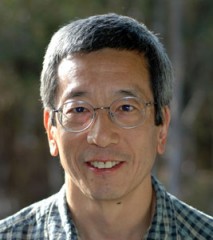Fluorescent nanoparticles highlight cancerous tissue on operating table
9 March 2010
Cell-penetrating molecules carrying fluorescent and magnetic tags that stick to and light up tumors help surgeons see more of the tumour tissue on the operating table and make it visible to MRI scans.
The technique was developed by a team of researchers at the University of California, San Diego and the Moores UCSD Cancer Center. The technique enabled scientists to spot and remove more cancerous tissue in mice injected with the fluorescent probes than in those mice without the fluorescent probes, increasing survival five-fold.
The findings, reported online in the Proceedings of the National Academy of Sciences, are the latest steps in research aimed at helping surgeons see the outlines of cancerous tumors in real time, and promise to open new doors to using molecular tools in the operating room.
 The
team was led by Howard Hughes Medical Institute investigator Roger
Tsien (photo on right), PhD, professor of pharmacology, chemistry
and biochemistry at the University of California, San Diego and the
Moores UCSD Cancer Center. Dr Tsien won a Nobel prize for his work
in creating fluorescent proteins that light up the inner workings of
cells.
The
team was led by Howard Hughes Medical Institute investigator Roger
Tsien (photo on right), PhD, professor of pharmacology, chemistry
and biochemistry at the University of California, San Diego and the
Moores UCSD Cancer Center. Dr Tsien won a Nobel prize for his work
in creating fluorescent proteins that light up the inner workings of
cells.
“The development of biological probes that can guide surgeons, rather than depending only on feel and normal ‘white light’ to see, can provide tools to navigate the body on a molecular level,” said first author Quyen Nguyen, MD, PhD, assistant professor of surgery at the University of California, San Diego School of Medicine and Nobel prize winner.
Surgeons often rely on feel, look and experience to tell if they have removed all of a tumor while sparing healthy tissue. While the patient lies on the operating table under anesthesia, tissue samples are quickly examined by pathologists, and remaining tumor tissue is sometimes missed, meaning further surgery or a greater likelihood of tumor recurrence.
Tsien, Nguyen and colleagues used synthetic molecules called activatable cell penetrating peptides (ACPPs) and microscopic nanoparticles to develop probes carrying fluorescent and magnetic tags. These tags make tumors visible to MRI and allow the tumors to “glow” on the operating table. The team wanted to see if the probes could aid surgeons in seeing more of the tumor, particularly the margins.
In a series of studies, working mainly in mice with implanted human tumors, the researchers showed that if tumors had spread to surrounding tissue, the ACCP-nanoparticle probes enabled them to visualize areas of tumors that they wouldn’t ordinarily see — either because the tissue was buried beneath other tissue or the tumor simply was difficult to distinguish from normal tissue.
Using a technique called PCR (polymerase chain reaction) to measure tumor DNA, they found that, on average, 90% fewer cancer cells remained after surgery to remove tumors in mice using the probe-based molecular guidance compared to surgery without it — a 10-fold reduction. They also found that the fluorescently labeled probes hit their mark 93— of the time, allowing the researchers to “see” left over tumor tissue.
According to the scientists, only a single injection of the nanoparticle-based probe containing the fluorescent and magnetic tags was needed in order to use MRI to examine the entire mouse model for tumors before and after surgery, in addition to the real-time guidance in surgery.
Nguyen said that in the future, additional tags may be added, and eventually, a cocktail of personalized probes may be designed for individual types of cancers. If the nanoparticle-based probes are successful in finding tumor cells in humans, the researchers envision using them eventually to deliver chemotherapy drugs to finish off the remaining cancer.
Tsien and Nguyen see many advantages to molecularly guided cancer surgery. Probes can be useful in staging cancer, particularly in prostate cancer, and can be used in a variety of tumor types. In addition, such biological probes can be used in laparoscopic and robotic surgery, where surgeons cannot feel the tumor, and rely much more on sight. If surgeons can completely remove a cancer, it may mean a patient could be cured quickly, and at relatively low cost when compared to long-term chemotherapy.